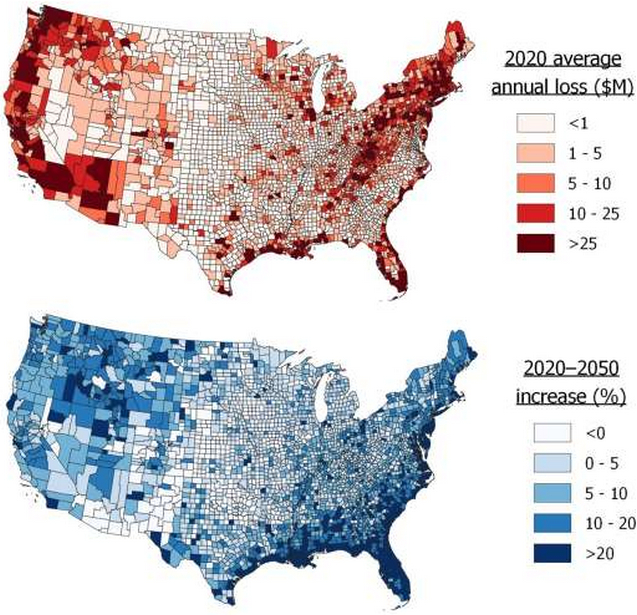
|
|
The extents of simulated design floods with a return period of 10,
100, and 1000 years in Des Moines, IA.
Credit: Fathom (fathom.global)
|
The University of Bristol-led study, published today in Nature Climate Change, deployed advanced modeling techniques to make the colossal calculations, which forecasted average annual flood losses would increase by 26.4% from US$32 billion currently to US$40.6 billion in less than 30 years.
By analyzing nation-wide property asset data and detailed flood projections, the team of leading international flood risk scientists developed for the first time a comprehensive, high-resolution assessment of flood risk in the US.
The estimates of financial loss, which include damage to homes, businesses and their contents, were based on 2021 dollar values so the actual numbers would likely be much bigger factoring in inflation.
While the research reveals poorer communities with a proportionally larger white population face the most danger at present, future growth in flood risk will have a greater impact on African American communities on the Atlantic and Gulf coasts.
Predicted population change was also shown to have a have a huge effect on flood risk, resulting in four-fold increases compared to the impact of climate change alone and sending costs further spiraling.

|
|
Maps showing the distribution of US flood risk (expressed as the
annual average loss due to flooding) by county, and its projected
change by 2050. Credit: Fathom (fathom.global)
|
"Typical risk models rely on historical data which doesn't capture projected climate change or offer sufficient detail. Our sophisticated techniques using state-of-the-science flood models give a much more accurate picture of future flooding and how populations will be affected.
"The mapping clearly indicates Black communities will be disproportionately affected in a warming world, in addition to the poorer White communities which predominantly bear the historical risk. Both of these findings are of significant concern.
The research is a call to action for adaptation and mitigation work to be stepped up to reduce the devastating financial impact flooding wreaks on people's lives."

|
|
The nationwide simulation of the 100-year design flood from
fluvial, pluvial, and coastal sources.
Credit: Fathom (fathom.global)
|
Co-author Professor Paul Bates CBE FRS, Professor of Hydrology at the university's Cabot Institute for the Environment and School of Geographical Sciences, said: "Current flood risk in western society is already unacceptably high, yet climate and population change threaten to inflate these losses significantly.
"The relatively short timescales over which this increase will take place mean we cannot rely on decarbonisation to reduce the risk so we have to adapt better, both to the situation now and for the future."
Links
- Indigenous communities face a higher risk of socioeconomic vulnerability due to flooding Simulations show long lag in the effect of global warming on Greenland's ice sheet volume
- Climate uncertainty colors flood risk assessment
- Flood risk to new homes in England and Wales will increase in disadvantaged areas
- Role of dams in reducing global flood exposure under climate change
- Once in a lifetime floods to become regular occurrences by end of century
- What's a 100-year flood? A hydrologist explains
- Study shows widespread retreat and loss of marine-terminating glaciers in the northern hemisphere
- Measuring climate change: It's not just heat, it's humidity
- One sea to many oceans: Oxygen flow and its role in sustaining life globally

No comments :
Post a Comment